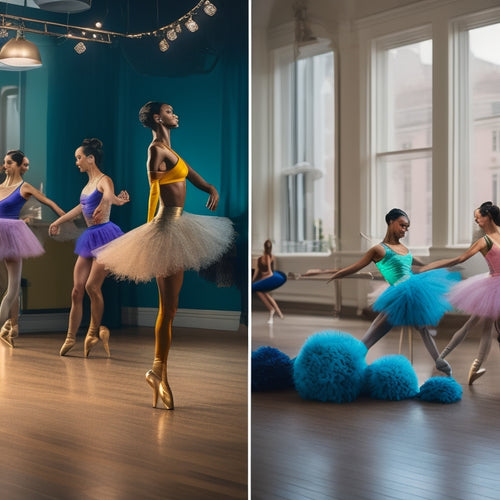
Belly Dance Exercises to Boost Flexibility
Share
As you stretch, sway, and shimmy, you'll discover that belly dance exercises offer a unique path to enhanced flexibility, combining fluid movements with targeted muscle engagement. By incorporating these exercises into your routine, you'll not only boost your range of motion but also cultivate a stronger, more supple body. From hip circles to chest opens, each movement is designed to awaken flexibility in a specific area, but the benefits don't stop there. By mastering these exercises, you'll reveal a newfound sense of bodily awareness, posture, and relaxation – but that's only the beginning.
Key Takeaways
• Master controlled hip movements through hip circles with varying size and speed to increase flexibility in inner thighs.
• Engage core muscles and focus on precise hip movements to develop pelvic awareness and isolation techniques.
• Improve shoulder mobility by lifting arms to a 90-degree angle, breathing deeply, and allowing the body to relax and move freely.
• Practice pelvic tilt techniques, maintaining a neutral spine, soft knees, and engaging core muscles to target specific lower back muscles and increase flexibility.
• Incorporate outer hip flexibility exercises, focusing on proper knee alignment, targeting outer hip muscles, and experimenting with slide variations.
Warm-Up Stretches for Flexibility
As you get ready to immerse yourself in belly dance exercises, start with a series of warm-up stretches to increase your flexibility and range of motion. This essential step prepares your muscles for the upcoming movements, reducing the risk of injury and promoting a smooth, fluid dance experience.
Begin by focusing on muscle relaxation, releasing any tension or stiffness in your neck, shoulders, and arms. As you inhale, lengthen your spine, feeling the expansion in your chest. Exhale, and allow your shoulders to drop, releasing any remaining tension.
Embracing a flexibility mindset, remember that flexibility isn't just about physical movement but also about mental openness. As you stretch, focus on your breath, letting go of any self-doubt or fear. Visualize your muscles lengthening, becoming more supple and adaptable.
With each stretch, repeat a mantra to yourself, such as 'I am flexible and strong.' By doing so, you'll cultivate a positive mindset, allowing you to approach the exercises with confidence and ease.
Hip Circles for Inner Thigh Flexibility
As you begin to incorporate hip circles into your belly dance routine, you'll notice improvements in your controlled hip movement, allowing for more fluid, dynamic movements.
You'll also experience increased flexibility in your inner thighs, thanks to the targeted stretching exercises.
Controlled Hip Movement
Mastering controlled hip movement is crucial for your hip joints and inner thighs, as it involves creating small, deliberate circles with your hips to increase flexibility. This subtle yet powerful movement is a fundamental component of belly dance, and getting it right is key.
As you practice controlled hip movement, focus on engaging your core muscles to maintain stability and control. This will help you isolate the movement in your hips, allowing you to create smooth, flowing circles.
To execute controlled hip movement, start by standing with your feet shoulder-width apart and your knees slightly bent. Engage your core muscles, then slowly begin to rotate your hips in a small circle. Keep your upper body still and relaxed, allowing your hips to do the talking.
As you get more comfortable, you can experiment with varying the size and speed of your circles, adding some flair to your dance expression. Remember to breathe naturally and maintain muscle engagement to avoid straining your muscles.
With practice, mastering controlled hip movement will become second nature, and you'll be able to express yourself with confidence and grace.
Inner Thigh Stretching
You'll find that mastering controlled hip movement sets the stage for more advanced techniques, such as hip circles that target your inner thigh flexibility. Now, it's time to focus on hip circles that will help increase your inner thigh flexibility.
Stand with your feet shoulder-width apart, with your knees slightly bent. Engage your core and keep your upper body still. Slowly move your hips in a large circle, first clockwise and then counterclockwise. Focus on squeezing and releasing your inner thigh muscles as you move.
Remember to breathe naturally and avoid bouncing or forcing your movements. As you practice hip circles, you'll start to feel a gentle stretch in your inner thighs. Take breaks to massage your thighs gently, focusing on the areas that feel tight. This will help increase blood flow and reduce muscle tension.
Stronger inner thighs will also improve your overall thigh strength, allowing you to move with more power and control. With consistent practice, you'll notice increased flexibility and a more fluid, expressive dance style.
Pelvic Isolation Drills
Master pelvic isolation drills by focusing on precise hip movements, which will help you achieve greater inner thigh flexibility and overall dance fluidity.
As you practice these exercises, you'll develop pelvic awareness, allowing you to control your movements with precision. Start by standing with your feet shoulder-width apart, engaging your core, and relaxing your shoulders. Slowly begin to move your hips in a large circle, first clockwise and then counterclockwise. Focus on isolating your pelvis, keeping your upper body still.
As you circle your hips, engage your glutes and lower abs to maintain control. Next, try smaller circles, gradually increasing your speed as you build muscle control. Remember to breathe naturally and avoid tensing your shoulders or chest.
Repeat this exercise several times, taking breaks to stretch your inner thighs and hips. With consistent practice, you'll improve your pelvic isolation, leading to increased flexibility and a more fluid dance style.
Arm Waves for Shoulder Mobility
As you stand with your feet shoulder-width apart, gently lift your arms to a 90-degree angle, keeping them relaxed and soft, allowing your shoulders to release any tension. This is the starting position for the arm wave exercise, designed to boost your shoulder mobility and enhance your belly dance expressions.
As you inhale, slowly lift your right arm, keeping it straight, and then lower it back down to the starting position. Repeat this movement with your left arm. Continue alternating arms in a slow, flowing motion, allowing your shoulders to relax and release any tension.
This exercise helps prevent arm injuries common in belly dance, such as shoulder strain and tendonitis, by increasing flexibility and range of motion. Remember to breathe deeply and naturally, allowing your body to relax and move freely. Focus on the sensation of your arms moving in harmony with your breath, and let your dance expressions unfold.
Chest Opens for Upper Body Flexibility
Now that your arms are relaxed and flexible, focus on opening your chest to expand your upper body flexibility, allowing your torso to sway and move with greater ease. This will enhance your overall belly dance movements and improve your posture.
To achieve this, follow these exercises:
-
Stand or sit up straight with your shoulders relaxed and down. Take deep breathing exercises, inhaling through your nose and exhaling through your mouth. This will help expand your chest cavity and improve your posture.
-
Engage in posture correction by imagining a string pulling your head up towards the ceiling. This will help elongate your spine and open up your chest.
-
Place your hands on a wall or door frame and lean forward, stretching your chest. Hold for 30 seconds and release.
-
Lie on your back with your arms extended overhead and slowly lift your arms up and down, stretching your chest.
-
Practice chest opens in front of a mirror, focusing on your posture and breathing.
Remember to practice these exercises regularly to see improvement in your upper body flexibility and overall belly dance movements.
Pelvic Tilts for Lower Back Flexibility
As you move on to pelvic tilts, you'll learn the basics of this fundamental movement, including how to execute a proper tilt and why it's essential for lower back flexibility.
You'll also discover variations that will help you target specific muscle groups and improve your overall range of motion.
Pelvic Tilt Basics
You'll begin by standing with your feet shoulder-width apart, with your knees slightly bent and your weight evenly distributed between both feet, as this stance allows for best pelvic movement. This position will help you engage your core and maintain balance throughout the exercise.
To perform a pelvic tilt, focus on these key elements:
-
Engage your core: Draw your belly button towards your spine to stabilize your pelvis and maintain control.
-
Tilt your pelvis: Slowly tilt your pelvis upwards and then back down again, keeping your upper body still.
-
Keep your knees soft: Allow your knees to bend slightly to absorb any movement and reduce pressure on your lower back.
-
Breathe naturally: Avoid holding your breath; instead, breathe naturally and focus on the movement.
-
Focus on the sensation: Pay attention to the sensation in your lower back and pelvis as you tilt, and adjust your movement accordingly.
Tilt Variations Explained
Building on the foundational pelvic tilt, you can modify this exercise to target specific areas of your lower back and increase flexibility by incorporating variations. These variations will help you engage your muscles more effectively and improve your spinal alignment.
One variation is the 'angled tilt,' where you tilt your pelvis at a 45-degree angle, targeting the muscles on one side of your lower back. This exercise helps to stretch and strengthen the muscles that support your spine. To do this, start in a neutral position, then slowly tilt your pelvis to one side, keeping your spine long and your core engaged. Hold for a few seconds, then return to neutral. Repeat on the other side.
Another variation is the 'circular tilt,' where you move your pelvis in a small circle, first clockwise and then counterclockwise. This exercise helps to increase flexibility and range of motion in your lower back. Remember to keep your core engaged and your spine aligned as you move your pelvis in a smooth, controlled motion.
Proper Posture Tips
Maintain a neutral spine by imagining a string attached to the crown of your head, gently pulling your head up and back, which helps to elongate your torso and promote proper posture. This is essential for effective pelvic tilts and overall lower back flexibility. As you engage in belly dance exercises, remember to prioritize spine alignment and core engagement to avoid putting unnecessary strain on your back.
To guarantee you're maintaining proper posture, keep the following tips in mind:
-
Engage your core muscles by drawing your belly button towards your spine
-
Keep your shoulders relaxed and down, avoiding scrunching up towards your ears
-
Imagine a straight line from the crown of your head to your heels, maintaining a long and lean posture
-
Avoid arching your back or leaning forward, which can put pressure on your lower back
-
Keep your weight evenly distributed on both feet, with knees slightly bent to absorb any movement
Knee Slides for Outer Hip Flexibility
Incorporating knee slides into your belly dance routine is crucial for targeting the outer hip muscles effectively, increasing flexibility and range of motion in this often-neglected area.
To get the most out of this exercise, it's important to focus on proper knee alignment. Make sure to keep your knees in line with your toes, avoiding any twisting or torque that can put unnecessary strain on your joints.
When performing knee slides, try experimenting with different slide variations to keep your practice engaging and prevent plateaus. Start with small, controlled movements, gradually increasing the distance and speed as you build flexibility and confidence.
You can also modify the exercise by changing the direction of your slides, alternating between lateral and circular motions to target different muscle groups. Remember to breathe naturally and maintain a relaxed posture, allowing your body to move freely and efficiently.
Figure Eights for Core Strength
As you've mastered the knee slides to improve outer hip flexibility, now focus on engaging your core with figure eights, a dynamic exercise that will challenge your torso's rotational strength and stability. This exercise is essential for belly dancing, as it improves your overall core engagement and muscle balance.
To perform figure eights, follow these steps:
- Stand with your feet shoulder-width apart, with your knees slightly bent.
- Engage your core muscles by drawing your belly button towards your spine.
- Imagine a large circle on the floor in front of you.
- Move your hips in a large, smooth figure-eight pattern, first clockwise and then counterclockwise.
- Focus on keeping your upper body still, with your arms relaxed by your sides.
Remember to:
- Start slowly and gradually increase your speed as you build confidence.
- Keep your core muscles engaged throughout the exercise.
- Focus on smooth, controlled movements to avoid straining your back or hips.
- Practice regularly to build strength and endurance.
- Listen to your body and stop if you experience any discomfort or pain.
Cool Down Stretching Exercises
Finish your belly dance workout with a series of cool down stretching exercises to lengthen your muscles, improve flexibility, and reduce muscle soreness. As you shift into relaxation mode, focus on slow, controlled movements to calm your mind and body.
Start by stretching your neck, gently tilting your head to the side, holding for 30 seconds, and then switching sides. Next, move on to your shoulders, rolling them forward and backward in a circular motion. Take deep breaths, inhaling through your nose and exhaling through your mouth, to calm your nervous system.
Incorporate relaxation techniques, such as visualization and progressive muscle relaxation, to further reduce muscle tension. Focus on your breath, imagining any remaining stress or fatigue melting away with each exhale. For best muscle recovery, hold each stretch for 20-30 seconds, breathing deeply and slowly.
Frequently Asked Questions
Can I Practice Belly Dance Exercises if I Have a Knee Injury?
"Did you know that 80% of dancers experience injuries? If you have a knee injury, you can still practice belly dance exercises with modifications. Prioritize knee safety by avoiding deep knee bends and opting for seated or lying-down movements instead."
Will Belly Dance Exercises Help Me Lose Weight Quickly?
You'll be pleased to know that belly dance exercises can indeed help you lose weight quickly, as they provide an effective calorie burn, boosting your weight loss journey while being gentle on your knees.
Can I Modify Exercises if I Have a Larger Body Type?
"Start with small steps, as the saying goes, and you'll find that gentle modifications can make all the difference for a larger body type. Focus on body awareness and adapt exercises to your comfort level, ensuring a safe and enjoyable experience."
Do I Need to Wear Specialized Clothing for Belly Dance Exercises?
When dancing, you'll want to wear comfortable, breathable fabric options that allow for freedom of movement, respecting the cultural significance of traditional belly dance attire, while prioritizing your safety and comfort.
Can I Practice Belly Dance Exercises During Pregnancy?
'Don't worry, pregnancy isn't a barrier to dance! You can practice modified belly dance exercises during pregnancy, promoting prenatal wellness and fetal bonding, but always consult your doctor first to guarantee a safe, healthy experience.'
Related Posts
-

Revolutionize Your Dance Makeup With Pro Tutorials
You're about to discover the hidden gems of your dance makeup skills with the latest digital tools and expert guidanc...
-

Best Dance Footwear for Comfort and Performance
When selecting the best dance footwear for comfort and performance, prioritize shoes with exceptional arch support an...
-

Exciting 'Dancer Doll' Sewing Pattern Released
The Dancer Doll sewing pattern is now available, offering a detailed guide to crafting a beautifully detailed doll. T...


